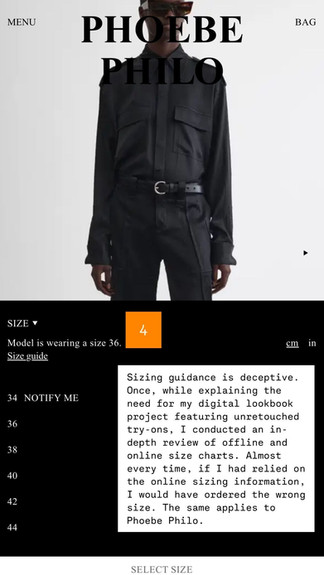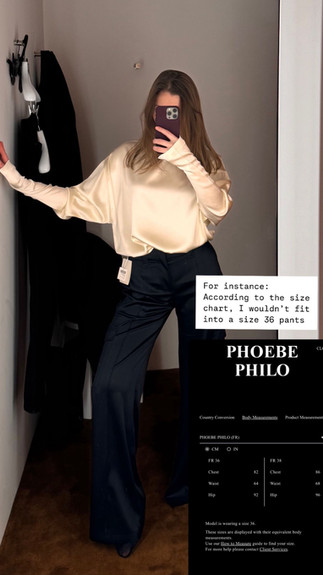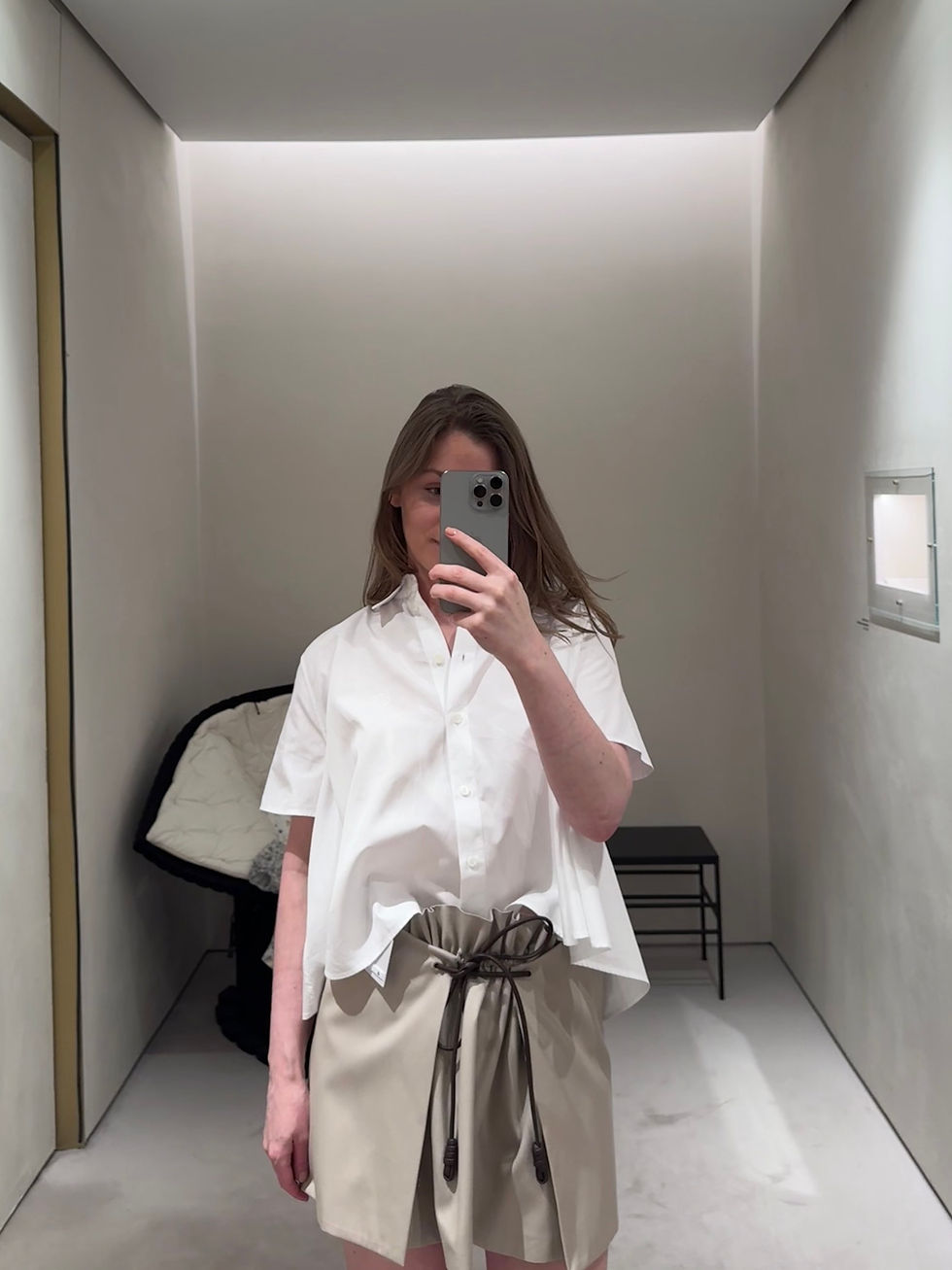The Phoebe Philo Brand: What’s Next? A Strategy Guide.
- Marina 2Jour

- May 6
- 11 min read
At the very last page of HTSI with Phoebe Philo as guest editor I was genuinely disappointed. I may only guess at the true motives of such a media appearance, but considering that Phoebe is not only a designer but also a business owner, I may assume the purpose, whether primary or not, was visibility. More specifically, given the audience for the Financial Times, it might be an attempt to talk to the core brand client.
But those are just my assumptions. Whatever the motive was — the method, or rather its manifestation, did not impress me. I am not sure there will be many who are impressed.
In this article, I will elaborate a bit more on why I was disappointed by the issue, the challenges of developing a new brand, and why the idea of "Why not launch their own brand?" has its nuances. Finally, I will reflect on how, in my opinion, the Phoebe Philo brand could reach a new level of development without significant investment or a complete change of trajectory, achieving financial return — if that is the goal, of course.
CONTENTS
1.1. FT audience
1.2. Phoebe Philo brand client
1.3. Practical solutions for better engagement in the edition
Challenges for newly launched brands in the luxury fashion industry
How the Phoebe Philo brand might evolve: a practical playbook
3.1. Sales channels: E-commerce
3.2. Sales channels: Wholesale
3.3. Product development
3.4. PR & communications
HTSI, FINANCIAL TIMES, GUEST EDITED BY PHOEBE PHILO: WHY IT MISSED THE MARK — AND WHAT COULD HAVE BEEN DONE BETTER
Some time ago, while exploring how to get the most out of advertising luxury and fashion in the FT Weekend editions, I reflected on the audience of this publication.
If we talk about the audience for the Financial Times, it typically includes:
Affluent, educated professionals — senior executives, investors, entrepreneurs, and policymakers
Culturally engaged readers — those interested in arts, design, fashion, literature, and lifestyle (especially the HTSI supplement)
Global business leaders — influential readers in fashion, design, and the creative industries
Age — generally 35+, with a strong presence in the 40–65 age group
High net worth individuals (HNWIs) and those with disposable income, interested in luxury markets, fine dining, travel, and collectible assets
For HTSI (How To Spend It) specifically, the audience includes:
Luxury consumers
Fashion insiders
Designers and brand decision-makers
People interested in design, architecture, and cultural trends
It is precisely the reader that makes this publication so attractive to the luxury business — Bernard Arnault and Axel Dumas have given interviews to it, and leaders from the fashion world share their strategic plans or talk about new launches in its pages. At the same time, there is a certain distinction between the weekday and weekend editions. The weekday issues have a clearer business focus, and any articles published there primarily serve as signals to investors. The weekend edition, however, is a bit more relaxed. You can pick out a new dress, a suit, or even choose a travel destination.
When I heard the news that Phoebe Philo would be a guest editor, I mentally checked the box. Also because, in recent times, fashion media has somewhat lost its footing in the information space, whereas newspaper supplements have been actively evolving. But first and foremost, I thought it was an excellent opportunity to speak to the brand’s potential customer. After all, who is the woman who wears Phoebe Philo?
The Phoebe Philo customer is a very distinct and refined audience, overlapping with her former Céline followers and a new wave of niche luxury consumers.
Who are Phoebe Philo clients?
Demographics & Geography
Women aged 30–65
Often professionally successful, with high disposable income
An important note: their income most likely stems directly from their own achievements and is relatively stable
High concentration in megacities
Taste & Preferences
Former Céline by Phoebe Philo fans (2008–2018) — women who valued her philosophy of “intelligent” fashion without excess or flashy branding
Quiet luxury consumers — those who seek understatement, quality, and a meaningful concept behind products, rather than logo-driven fashion. Here, we see some overlap with The Row, although I don’t find the offerings of these brands too similar — let alone identical
Creative industries — architects, interior designers, gallerists, art consultants, creative directors, stylists, fashion editors. I’ve recently spotted PP on Oprah Winfrey and Rosie Huntington-Whiteley, if that gives some context to the client type
Altogether, this makes HTSI a perfect platform to deliver the message — whatever the message is. The problem is, no matter how hard I tried, I couldn't catch the message.
In the editor's letter, Phoebe mentions everyone except herself — those who are "all passionately dedicated to their vocation." Then there’s a care package — a list of Phoebe’s go-tos for garment care. The lint roller, Vanish, and sewing machine captivated me because garment care routines are my secret obsession. But more broadly, I doubt a Phoebe Philo brand client would do their own laundry — especially not for Phoebe Philo items, most of which, I’m quite sure, are dry clean only. Sharing-caring is probably meant to create an emotional bond, but I would expect such a down-to-earth theme from a more contemporary brand.
Going further, there is a photoshoot featuring a mix of current and vintage styles. The current pieces are all by Phoebe Philo, while the vintage ones are by Maison Margiela, Vivienne Westwood, Comme des Garçons, and even Adidas. I like the concept, although I have two thoughts for which I don’t have clear answers:
Can it be considered a vanity fair of sorts that no contemporary designs from other brands were included in the shoot?
Could the mix with intellectual fashion be seen as an additional touch reflecting the Phoebe Philo client, as well as her personal perception of her brand’s identity?
But these are just side notes. On the other hand, if there’s an opportunity to use the magazine pages as an advertising platform — why not take advantage of it?
That’s really all. Nothing in particular distinguishes the issue under Phoebe Philo’s direction from any other. As a loyal reader, I make note of that.
This was a rare opportunity to strengthen the emotional connection between brand and client — and it was underused. Phoebe Philo generally avoids media appearances — she rarely gives interviews, and the way her brand communicates with the world can also be described as introverted. The actual content lacked this level of engagement and felt too generic for such a niche, loyal audience.
So, how could this opportunity have been used to engage the reader more effectively (in the making since at least January, when the first news arose), inspire potential customers to make a purchase, and strengthen the connection with existing ones?
A conversation between Phoebe and a brand client — ideally someone prominent who embodies the client profile we discussed earlier.
An article about Phoebe herself — with personal touches, such as how she balances her role as a designer and business owner. Her personal tastes, influences over time, and insights into the launch of the brand, which reportedly faced several delays. The background of that process would definitely have added value.
A combined format — a warm, friendly dialogue in the style of FT Lunch.
In addition, I definitely would have included a selection curated by Phoebe, possibly even featuring Vanish again. But besides garment care products, I’d add places, books, exhibitions, inspiring works of art, and travel destinations — this would present not just a niche perspective but a lifestyle that resonates with the brand’s positioning.
And I would also have included a photoshoot featuring Phoebe herself. In Phoebe Philo head-to-toe, obviously. It’s no secret that she often chooses visually similar models for lookbooks, and the clothing itself is frequently inspired by her personal style. Remember the hair tucked into collars in product shots? That was something Phoebe herself sometimes did at the end of runway shows. Admittedly, this would have been a difficult task considering how rarely she appears in the press — but it would have added meaning between the lines to the brand’s positioning.
Challenges for Newly Launched Brands in the Luxury Fashion Industry
Every time I hear the familiar complaint that a designer “should just launch their own label because their vision and style are so distinctive and recognizable,” I can’t help but think of the main challenge this kind of business will inevitably face.
Launching your own brand requires big money — very big money. And there’s no guarantee the investment will pay off. It involves setting up the entire production chain, from sourcing materials to logistics. Then comes distribution — and here, there are two paths.
Either the new brand relies entirely on itself and builds its own sales network: an online store (which is much harder than it may seem) and physical retail, which is equally complex and expensive.
Or it turns to wholesale, sacrificing a percentage of sales but gaining a relatively stable volume of orders.
Add to this the need to plan production volumes, establish pricing policies, and fund marketing — which will definitely eat up a significant portion of the budget, especially in the early stages. And all of this takes time. It also means that the designer will inevitably become involved in less creative tasks: the daily operations and routines that nearly every startup faces in its early years (and early usually means several years, at best). Appealing? Especially considering that the brand may succeed… or may simply fizzle out.
That’s why there aren’t many investors willing to back such ventures — it’s much safer to work within the structure of major conglomerates and well-established brands, where the processes are already in place and there’s strong brand recognition. As well as there are no many designers willing to risk that way.
Phoebe Philo took the risk, with the support of LVMH as a minority investor.
HOW THE PHOEBE PHILO BRAND MIGHT EVOLVE: A PRACTICAL PLAYBOOK
By default, we assume that the Phoebe Philo brand, like any other business, exists to create value and generate profit. One cannot exist without the other, and they are closely interconnected. Based on this, I will outline the main areas where I see potential growth, as well as opportunities that have not yet been fully realized.
Sales Channels: e-Commerce
The brand chose an online shop as the main (and, for a period at the beginning, the only) sales channel. The logic behind this decision is clear:
full control over pricing, customer experience, and brand presentation.
better margins — no need to give up a percentage to wholesalers or retailers.
direct customer data — extremely valuable for building a niche, loyal audience.
On the other hand, such a decision requires a strong team behind the e-shop, both in terms of technical support and merchandise presentation. Here, I feel there’s a gap. I’ve previously mentioned some problems with the online shop, which were further compounded by the fact that there was no other place to view the items, either online or offline.
Here is a problem–solution breakdown of some issues on the website.
Given that this is the main sales channel, it’s essential to make it perform. Apart from visuals, there are plenty of missed opportunities for cross-selling and up-selling.
Sales Channels: Wholesale

















































